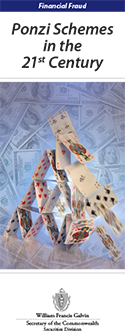Ponzi Schemes in the 21st Century
Download the brochure (PDF)
 In 2008, Bernard Madoff confessed that his long-standing asset management business was “one big lie,” built as a massive, multibillion dollar Ponzi scheme. Madoff’s fraud led many to financial ruin, and his name now signifies one of the largest Ponzi schemes in history.
In 2008, Bernard Madoff confessed that his long-standing asset management business was “one big lie,” built as a massive, multibillion dollar Ponzi scheme. Madoff’s fraud led many to financial ruin, and his name now signifies one of the largest Ponzi schemes in history.
Ponzi schemes are damaging, but they also are fairly easy to detect. A few simple actions can help you avoid financial catastrophe.
What is a Ponzi scheme?
Ponzi schemes are named after Charles Ponzi, a con artist who ran scams in the 1920s. The schemes are built by using future investor funds (rather than actual profits) to pay existing investors.
In a Ponzi scheme, claims of underlying investments are bogus. Very few, if any, actual physical assets or financial investments exist. The scheme can only survive if it continues to recruit new investors. If not, the scammer can’t pay off promised returns and cover investor cash-outs.
In many cases, the perpetrator uses investment money for personal expenses, further depleting funds and accelerating the scheme’s downfall.
The Madoff case
For decades, Madoff delivered consistent and steady annual returns—but not through legitimate means. He used elaborate, fabricated documentation to convince investors that their money lived in actual investments. But there were no actual investments, and no actual returns. Madoff paid the initial investors with money provided by new investors.
In 2008, as the global economy declined, many Madoff customers asked to cash out their investments. Madoff did not have enough money to cover his investors’ requests, and he couldn’t rely on new investor money in the economic downturn. His scheme finally crumbled.
How to avoid Ponzi schemes
- Avoid investments with unrealistic return promises. These are clear signs of a Ponzi scheme. Any legitimate investment involves risk. “Too good to be true” is a red flag.
- Diversify everything. Don’t put all of your money in a single investment. Diversify assets, money managers, accounts, and financial institutions. This limits exposure to the financial problems of any single institution.
- Don’t just rely on reputation or word of mouth. Con artists can build networks of trust and lure investors into believing they have an inside track on a hot investment.
- Verify investment details. Ask detailed questions and get clear answers before you invest. If the investments aren’t clearly explained to you, walk away. If you don’t understand an investment, don’t invest.
- Check the auditor. Auditors sign and certify financial statements for companies and investment funds. Investors rely on these audit reports, because auditors are liable for inaccuracies. A legitimate investment company would use a reputable auditing firm.
- Run a background check. Check with the Secretary’s office to determine if the individuals and firms selling the investment are properly registered with the Commonwealth of Massachusetts. Anyone selling a security must be registered. If the promoter claims an exemption, confirm that claim with the regulator. You can also check the promoter’s complaint history.
- Report fraud. If you believe you may be a victim of a Ponzi scheme, contact the Secretary’s office. Local regulators can investigate the complaint, and report may prevent others from being victimized.
Contact information for all state securities regulators is available on the North American Securities Administrators Association website at www.nasaa.org.